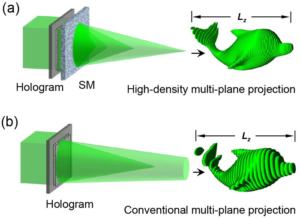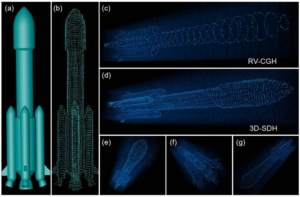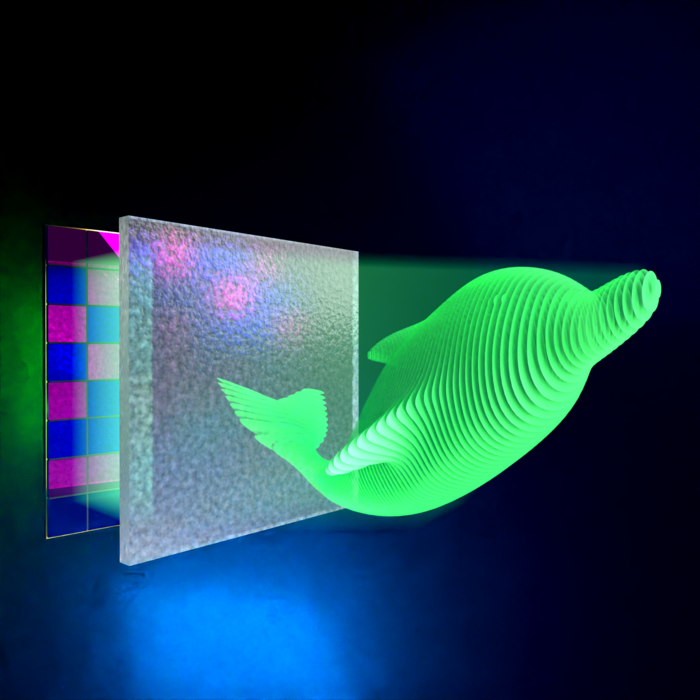Researchers have developed a new method for creating realistic 3D holographic projections that are three orders of magnitude better than the current state-of-the-art technology. Previous attempts to improve the resolution of holograms have run into three basic roadblocks. However, this new ultrahigh-density method shows that two of those have now been solved, dramatically improving the overall quality, resolution, and appearance of holographic projections.
“Our new method overcomes two long-existing bottlenecks in current digital holographic techniques — low axial resolution and high interplane crosstalk — that prevent fine depth control of the hologram and thus limit the quality of the 3D display,” said Lei Gong, who led a research team from the University of Science and Technology of China. “Our approach could also improve holography-based optical encryption by allowing more data to be encrypted in the hologram.”
Limitations of Current Methods for Generating Holograms
With present technology, producing a hologram of actual three-dimensional objects that is realistic in appearance involves projecting the desired images onto a predetermined number of successive layers that are very close together. The closer, the better, as the density of the images is key to providing the depth cues our eyes and brains use to determine the “reality” of an object.
However, creating such a realistic-looking hologram requires a spatial light modulator (SLM), a specialized piece of equipment that modulates the intensity and phases of the light beam. Still, even with the best SLMs, the best holograms are still limited in quality because only a few low-resolution images can be projected onto separate layers and with a low-depth resolution.


Hoping to change this equation, the researchers combined a traditional SLM with something called a diffuser that, according to the press release announcing the breakthrough approach, “enables multiple image planes to be separated by a much smaller amount without being constrained by the properties of the SLM.”
The researchers also guessed that by limiting the “crosstalk,” or bleed over of image data between the layers and exploiting the benefits of light scattering and wavefront shaping, they could potentially create ultrahigh-density holograms that are significantly more data-dense and, therefore, way more realistic in appearance.
Tests Show the new Technique is three orders of magnitude better than current Methods
With their approach set, the team tested their idea in simulation software to see if the diffuser would help them produce 3d constructions that had a much smaller distance between layers. According to the release, “they were able to project a 3D rocket model with 125 successive image planes at a depth interval of 0.96 mm in a single 1000×1000-pixel hologram, compared to 32 image planes with a depth interval of 3.75 mm,” using another state of the art holography approach known as random vector-based computer-generated holography. The researchers call their new process three-dimensional scattering-assisted dynamic holography (3D-SDH).


CREDIT: Lei Gong, University of Science and Technology of China
Sure enough, when the holograms were compared side by side, the 3D-SDH achieved an axial resolution of more than “three orders of magnitude” over the conventional counterpart. Although it is not a direct comparison in terms of resolution, improving television resolution three orders of magnitude would be equivalent to jumping from standard definition TV of the 20th century right past 720p High-Def and 1080p High-Def and going straight to 4K. That is a significant improvement.
Next Steps to Creating Realistic Holograms
The researchers behind the new method, which was published in the peer-reviewed journal Optica, point out that all of the holograms they demonstrated in their experiments were point-cloud images, which means they cannot present what they term a “solid body” of a 3D object, but simply a much denser holographic projection than currently available. Still, the researchers say they would like to improve and refine their method until they are able to project a collection of realistic-looking 3D objects as opposed to just a single object. And they note such an improvement to the point of realistic 3D holograms would have uses in both virtual reality and real-world applications.
“A 3D hologram can present real 3D scenes with continuous and fine features,” said Gong. “For virtual reality, our method could be used with headset-based holographic displays to greatly improve the viewing angles, which would enhance the 3D viewing experience. It could also provide better 3D visuals without requiring a headset.”
Christopher Plain is a Science Fiction and Fantasy novelist and Head Science Writer at The Debrief. Follow and connect with him on Twitter, learn about his books at plainfiction.com, or email him directly at christopher@thedebrief.org.

